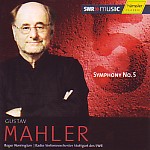The Adagietto of Mahler’s Fifth contains 103 bars, and in this brief span we find the following indications of the music’s emotional climate: espressivo (bar 2), seelenvoll [soulful] (bar 3), espressivo (bar 6), espressivo/seelenvoll (bars 11/12), espressivo (bars 19/20), mit Empfindung [with emotion] (bar 23), espressivo (bar 22), mit Wärme [with warmth] (bar 38), grosser Ton [big sonority] (bars 38/39), espressivo (bar 41), espressivo (bar 64), molto espressivo (bar 73), espressivo (bar 79), vibrato, mit innigster Empfindung [with the most inward emotion] (bar 87), viel Ton [lots of sonority] (bar 95). In the second movement the lonely cello recitative at the start of the development section is marked “klagend” (lamenting), and then “semper pp ma espressivo” a few bars later. The lovely waltz for strings after the scherzo’s opening section is marked “zart” (tender).
Roger Norrington seems to think that he can realize all of these expressive indications with the near-total denial of vibrato. He is wrong. The combination of thin, inhibited string tone with a generous observance of portamento offers a caricature of how this music should sound. The result is an emotionally emasculated Fifth Symphony. I’m not going to rehash at length the fallacious historical “evidence” Norrington adduces to justify his view, and his interpretation is not, in fact, entirely bereft of interest. The winds play very well (the brass less so), textures are crystal clear, and there’s plenty of excitement in the first two movements. Indeed, the second goes extremely well (after a somewhat shaky start), with plenty of turbulence, and its manic highs and lows are effectively realized. The orchestra also deserves credit for giving Norrington exactly what he wants.
However, we also have to set against the occasional flash of brilliance Norrington’s chronic insensitivity to dynamics (pianissimos are few and far between; the opening trumpet solo, for example, starts loud and barely manages a crescendo), and his erratic handling of tempo. The first-movement funeral march starts terribly quickly, then finds itself forced to slow down to a more normal speed so as to make the necessary contrast with the first wild outburst. That’s just clumsy. The finale, however, is lively and cleanly phrased, the ending suitably joyous. At quick tempos, string timbre isn’t such an issue because no one uses vibrato when the notes aren’t sustained long enough for it to be worth the trouble. But I suspect most listeners will find this reading satisfying only if they prefer Norrington’s ideas to Mahler’s.
In sum, there are many, many versions that have far more to offer than this sterile, passionless exercise by a conductor seeking validation not by offering a compelling interpretation, but by rewriting history to comport with some half-baked assertions about an idiomatic orchestral style. Oh, and by the way, Norrington likes to cite Bruno Walter’s 1938 Mahler Ninth as evidence that the Vienna Philharmonic avoided vibrato until after World War II. It just so happens that Walter also recorded, at exactly the same time, and with that same orchestra, the Adagietto of Mahler’s Fifth. It is not a performance noteworthy for its absence of vibrato. But then, this is equally true of Walter’s Ninth, and his Das Lied von der Erde of two years earlier.
































